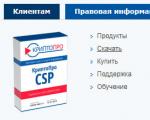What to do if the toolbar disappeared in MS Word. The Quick Launch bar disappeared, what should I do? Quick Access Toolbar not working
I have missing panel quick start , along with all the icons, how to restore it now and whether it is possible to place more than three icons there. Saw at our system administrator there are ten program shortcuts on the quick launch panel, when asked how to do this, the spell must be said. Well, if you're serious?
Quick launch bar missing
You know, Tatyana, it also disappeared from me somewhere, I really don’t use it, it’s probably the virus that steals it from everyone, let’s try to figure it out together.
Right-click on the taskbar, then the toolbar, check the box Quick Start and our missing quick launch bar appears where it should be.

I don’t know about you, but I didn’t have anything, let’s remember the old XP settings, mastering the seven and eight is good, but you shouldn’t forget old friends either. Right-click again on the taskbar and select properties,

look in the taskbar tab there should be a checkmark Displaypress quick launch bar, if it is not there, then we put it.

If in this case the quick launch bar did not appear, then the icons were removed manually, we try to reboot and drag the icons we need with the mouse to the lower left corner of the taskbar, three program icons should remain in the quick launch bar.
It rarely happens, but the two methods described above do not help either, then we read further, and at the same time consider the question: How to place a quick Windows startup XP is the number of shortcuts we need without a spell? After all, the allotted space is very small and instead of the icons we need, two arrows pointing to the right are displayed, which open the list of programs that do not fit into the quick launch bar.
Right-click on the taskbar and uncheck the Lock the taskbar item,

as you can see, the delimiter immediately appears, hover over it with the mouse and it takes the form of a double arrow,
click on it with the left mouse and without releasing it, move it to the right as far as necessary, release the mouse and fix the taskbar. That's all, now we drag the shortcuts we need to the launcher with the mouse,

even if there are ten of them. In this case, the quick launch bar will definitely appear.

If you can't get the Minimize All Windows icon back, open Notepad and type in the text and save it with an extension. scf, then drag it with the mouse to the quick launch bar.
In a programme Microsoft Word toolbar gone? What to do and how to get access to all those tools without which working with documents is simply impossible? The main thing is not to panic, as it disappeared, it will return, especially since finding this loss is quite simple.
As they say, everything that is not done is for the best, so thanks to the mysterious disappearance of the quick access bar, you can learn not only how to return it, but also how to customize the elements that appear on it. So let's get started.
If you are using Word 2012 and higher, you only need to press one button to return the toolbar. It is located in the upper right part of the program window and looks like an upward arrow located in a rectangle.

Press this button once, the disappeared toolbar returns, press again - it disappears again. By the way, sometimes it really needs to be hidden, for example, when you need to completely and completely concentrate on the content of the document, and so that nothing extra is distracting.

This button has three display modes, you can choose the appropriate one just by clicking on it:
- Automatically hide the ribbon;
- Show only tabs;
- Show tabs and commands.

The name of each of these display modes speaks for itself. Choose the one that is most convenient for you while you work.
If you are using MS Word 2003 - 2010, you must perform the following manipulations to enable the toolbar.
1. Open the tab menu "View" and select the item "Toolbars".
2. Check the boxes next to the items that you need to work.
3. Now all of them will be displayed on the Quick Access Toolbar as separate tabs and/or groups of tools.
Enabling Individual Toolbar Items
It also happens that “disappears” (is hidden, as we have already figured out) not the entire toolbar, but its individual elements. Or, for example, the user simply cannot find any tool, or even an entire tab. In this case, you need to enable (configure) the display of these same tabs on the Quick Access Toolbar. You can do this in the section "Options".
1. Open a tab "File" on the Quick Access Toolbar and navigate to "Options".

Note: In earlier versions of Word, instead of a button "File" there is a button "MS office".
2. In the window that appears, go to the section "Customize Ribbon".

3. In the Main Tabs window, check the boxes next to the tabs you need.

- Advice: By clicking on the plus sign next to the tab name, you will see lists of tool groups that these tabs contain. Expanding the "pluses" of these items, you will see a list of tools presented in groups.
4. Now go to the section "Quick Access Toolbar".

5. Section "Select commands from" select item "All Teams".

6. Go through the list below, finding the necessary tool there, click on it and click the button "Add" between windows.

7. Repeat the same step for all other tools that you want to add to the Quick Access Toolbar.
Note: You can also delete unwanted tools by clicking the button "Delete", and sort their order using the arrows located to the right of the second box.
- Advice: In chapter "Customizing the Quick Access Toolbar", located above the second window, you can choose whether your changes will be applied to all documents or only to the current one.

8. To close the window "Options" and save your changes, click the button "OK".
Now on the quick access panel (toolbar), only the tabs you need, tool groups and, in fact, the tools themselves will be displayed. By properly configuring this panel, you can noticeably optimize work time resulting in increased productivity.
Excel for Office 365 Word for Office 365 Outlook for Office 365 PowerPoint for Office 365 Publisher for Office 365 Access for Office 365 Visio Plan 2 Visio Professional 2019 Visio Standard 2019 Visio Professional 2016 Visio Standard 2016 Visio Professional 2013 Visio 2013 Visio Premium 2010 Visio 2010 Visio Standard 2010 Excel 2019 Word 2019 Outlook 2019 PowerPoint 2019 OneNote 2016 Publisher 2019 Access 2019 OneNote 2013 OneNote 2010 Project Professional 2019 Excel 2016 Word 2016 Outlook 2016 PowerPoint 2016 Publisher 2016 Access 2016 InfoPath 2013 Project Professional 2016 Excel 2013 Word 2013 Outlook 2013 PowerPoint 2013 Publisher 2013 Access 2013 Excel 2010 Word 2010 Outlook 2010 PowerPoint 2010 Access 2010 Publisher 2010 Project 2010 InfoPath 2010 SharePoint Designer 2010 Office 2010 Project Online Desktop Client Project Professional 2013 Project Standard 2010 Project Standard 2013 Project Standard 2016 Project standard 2019 SharePoint Workspace 2010 Less
The Quick Access Toolbar is configurable and contains a set of commands that are independent of the tab displayed in this moment on the tape. You can move the Quick Access Toolbar to one of two possible locations, and add buttons to it to perform various commands.
Notes:
Intended action:
Adding a Command to the Quick Access Toolbar

Adding a command that is not on the ribbon to the Quick Access Toolbar
Press the button and select an item from the menu Other commands.

Listed Select commands from select item Commands not on the ribbon.
Find the desired command in the list and click the button Add.
Advice: If you can't find the right command for commands, not included in the tape list, try asking commands to choose For all teams.
Removing a command from the Quick Access Toolbar
Right-click the command you want to remove from the Quick Access Toolbar and select context menu paragraph Remove from Quick Access Toolbar.
Reorder commands on the Quick Access Toolbar
Customizing the Quick Access Toolbar.
In the window Customizing the Quick Access Toolbar click the command you want to move and click the arrow Move Up or Move down.
Grouping commands by inserting a separator between them
Commands can be grouped using a separator to make the Quick Access Toolbar look like it contains sections.
Right-click the Quick Access Toolbar and choose from the context menu Customizing the Quick Access Toolbar.
Listed Select commands from select item Frequently used commands.
Select <разделитель> and press the button Add.
Use the arrows to place the separator in the right place Move Up And Move down.
Moving the Quick Access Toolbar
There are two options for placing the Quick Access Toolbar.
Upper left corner in the title bar. (default location)

under the tape

If you don't like the current location of the Quick Access Toolbar, you can move it to a different location. If you feel that the place next to the program icon is too far from the work area, you can move the panel closer. When the panel is located below the ribbon, it somewhat limits the size of the work area. So if you want to extend it, it's best to leave the Quick Access Toolbar where it is by default.
Click the button Customizing the Quick Access Toolbar(on the right side of the quick access bar).
Select an item from the list Place under the tape or Place above ribbon.
Customizing the Quick Access Toolbar with Options
With the command Options You can add commands to the Quick Access Toolbar, remove them, and change their order.
Open a tab File.
On the menu Reference select item Options.
Click the button Quick Access Toolbar.
Make the necessary changes.
Restoring Default Settings for the Quick Access Toolbar
Right-click the Quick Access Toolbar and choose from the context menu Customizing the Quick Access Toolbar.
In the window Customizing the Quick Access Toolbar press the button Restore default settings and select command Restore Quick Access Toolbar Only.
Export Customized Quick Access Toolbar
Ribbon and Quick Access Toolbar settings can be exported to a file that other employees can import and use on their computers.
Open a tab File.
On the menu Reference select item Options.
Click the button Quick Access Toolbar.
Click an item Import and export and select command Export all settings.
Importing a Customized Quick Access Toolbar
You can import a settings file to change the current appearance ribbons and quick access panels. Importing settings allows you to ensure the same appearance of applications Microsoft Office all employees or just on different computers.
Important: When you import the Ribbon Customizations file, any previously configured Ribbon and Quick Access Toolbar settings will be lost. If the current settings need to be restored, they should be exported before importing the settings file.
Open a tab File.
On the menu Reference select item Options.
Click the button Quick Access Toolbar.
Click an item Import and export and select command Import settings file.
For more information about customizing the ribbon, see Customize the Ribbon in Office.
Reasons for the green ball icon
A green ball icon is displayed if a custom group or command has been added to the Quick Access Toolbar after customizing the ribbon, but has not been assigned an icon.
This icon is used in the following cases:
when adding a custom group to the Quick Access Toolbar;
so that the user-customized ribbon can be distinguished from the default ribbon.
Add an icon representing a custom group or team
Open a tab File.
In Group Reference press the button Options.
Click the button Ribbon customization.
In the window Ribbon customization on the list Ribbon customization select the added custom group or team.
Click an item Rename and then in the list Symbol click icon.
In the dialog box Renaming press the button OK.
For more information about customizing the ribbon, see
"Quick Launch Panel" appeared in Windows versions xp. Windows 10 also has Quick Launch, but you need to enable it first.
How to enable Quick Launch in Windows 10
Click on "Taskbar" with the right mouse button. In the window that opens, move the mouse cursor over “Panels” and select “Create Toolbar...” from the drop-down list:
In the "New Toolbar" window that opens, select the desired folder and click the "Select Folder" button. After this action, a fixed link will appear on the "Taskbar" to access the folder you have selected:

Customizing the Quick Launch
To customize the created "Quick Launch Panel", you need to disable the pinning of the "Taskbar" (you may already have it disabled earlier). To do this, right-click on an empty space on the "Taskbar" and uncheck the box "Lock the taskbar".
Now you can customize the appearance of the "Quick Launch Bar", for example, change the name or move it to a different location on the "Taskbar". After the settings, pin the "Taskbar" again.
Removing the Quick Launch
To remove the panel, you need to right-click on the "Taskbars", select the "Panels" section and uncheck the "Quick Launch Panel" you created.
If you have any questions - ask them in the comments, we will be happy to help you.




